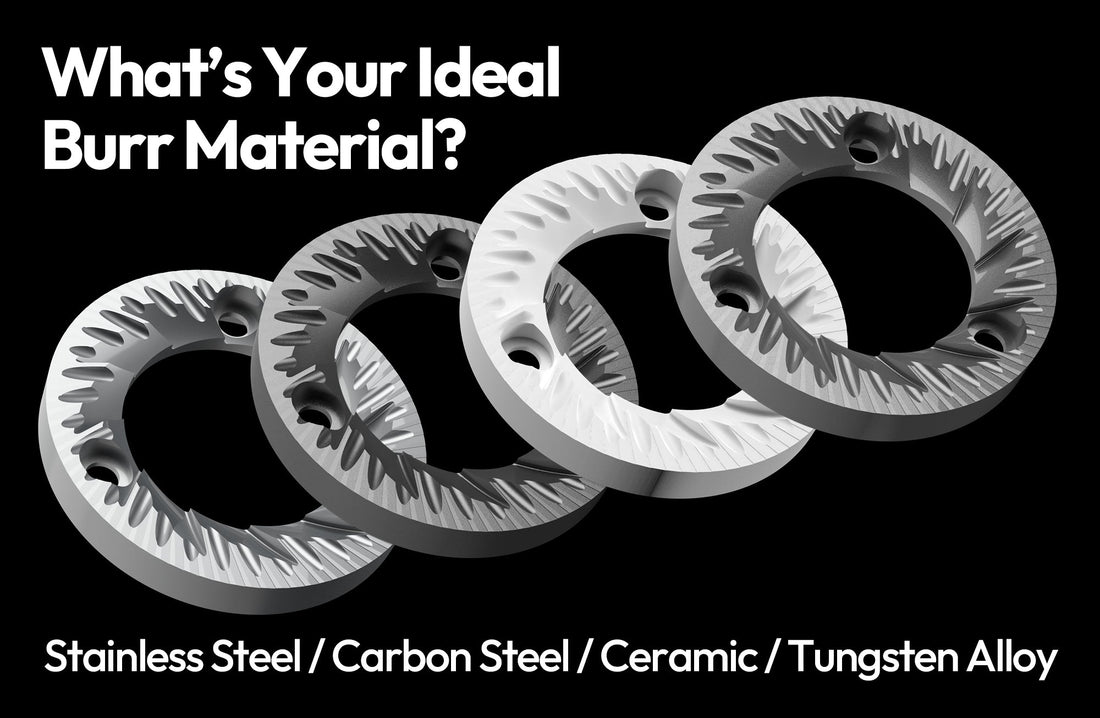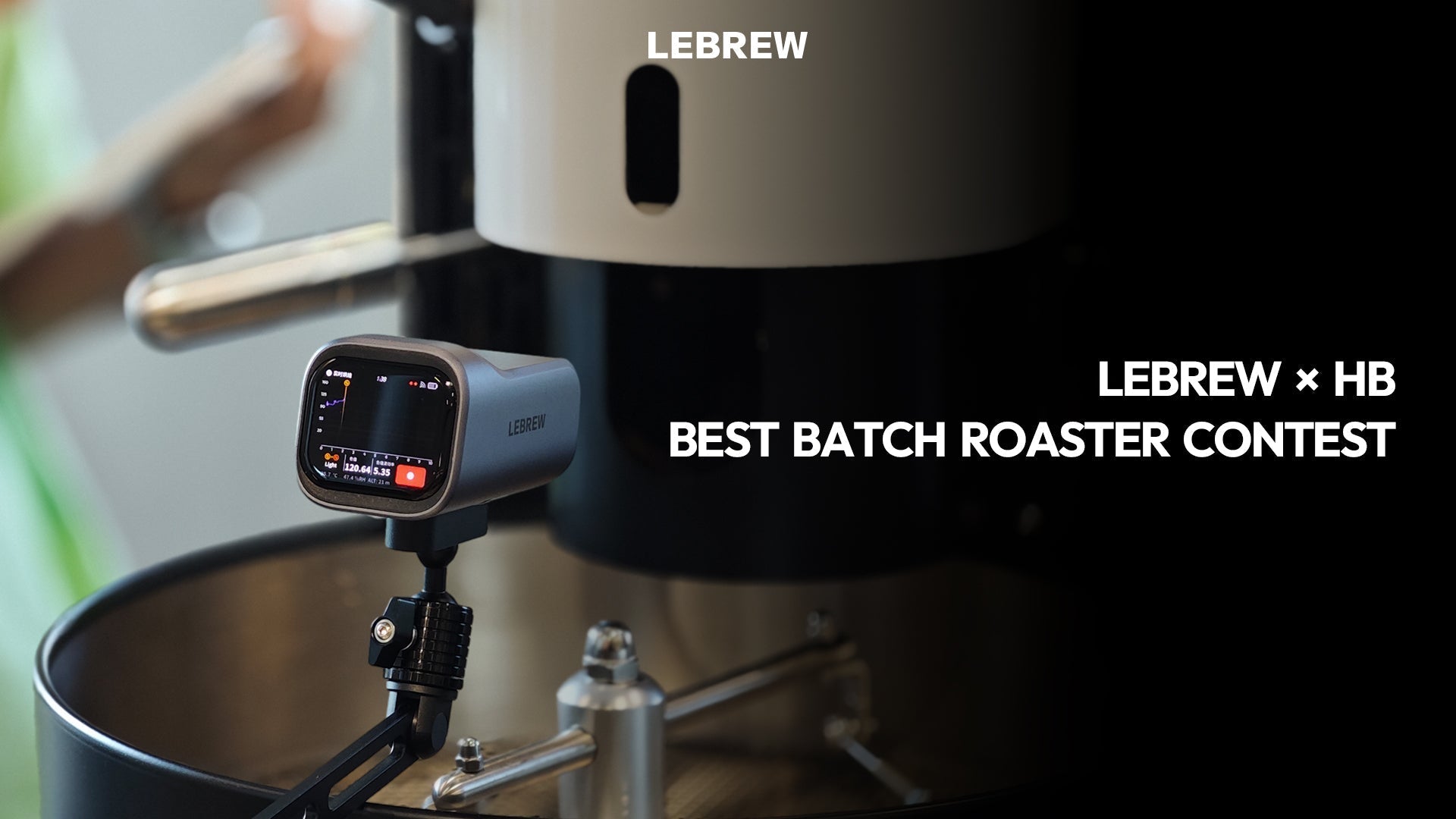What Materials Are Used to Make Coffee Burrs?

Abstracts
The quality of coffee is largely determined by the particle size distribution of the coffee grounds during the grinding process. As the core component of coffee grinders, the material of the burrs directly affects both the grinding performance and the longevity of the equipment. As a leading brand in the coffee grinding industry, LEBREW has earned high recognition from coffee enthusiasts and professionals alike for its outstanding performance in burr material selection and manufacturing processes. The HyperBurrs, for example, can be made from a variety of materials, including SUS440C, DC53, M2 powder steel, and tungsten carbide.
1. The Importance of Burr Material
The burr is the most crucial and central component of a coffee grinder. It is responsible for grinding the coffee beans into fine powder. The material of the burr not only determines its hardness, wear resistance, and corrosion resistance but also affects grinding consistency, particle size distribution, and ultimately the flavor of the coffee. Therefore, understanding the characteristics of different materials is essential when selecting the right grinding equipment.
LEBREW employs high-precision 5-axis CNC machining technology. Through computer-controlled precision cutting and polishing, LEBREW ensures that each burr's size and blade angle meet strict standards. To further enhance the burr's hardness and toughness, LEBREW utilizes advanced vacuum heat treatment and deep-cold processes. Choosing the right burr material not only improves the coffee's flavor but also ensures high efficiency and stability during the grinding process. This article will provide a detailed analysis of common burr materials, including stainless steel, ceramic, carbon steel, and tungsten carbide, exploring their performance in terms of durability and grinding effectiveness to help you make an informed choice.


2.Common Burr Materials
2.1 Stainless Steel
Features and Advantages:
- High Durability: Stainless steel has excellent corrosion resistance and wear resistance, allowing the burr to maintain its sharpness and shape over prolonged use.
- Easy to Maintain: The smooth surface of stainless steel burrs makes them easy to clean, reducing the accumulation of coffee oils and residues.
- Moderate Cost: Compared to other high-end materials, stainless steel burrs are more affordable to manufacture, making them suitable for most consumers.

Grinding Performance:
Stainless steel burrs typically feature a flat burr design, making them suitable for a variety of grinding needs. Their sharp edges efficiently cut the coffee beans, providing consistent grinding particles. However, due to the high thermal conductivity of metal materials, prolonged grinding may cause the burrs to overheat, potentially affecting the flavor of the coffee.
2.2 Ceramic
Features and Advantages:
- High Hardness: Ceramic burrs have high hardness and are resistant to wear, allowing them to maintain sharpness over an extended period.
- Low Heat Conduction: Ceramic materials have low thermal conductivity, reducing heat buildup during grinding, which helps preserve the aroma and flavor of the coffee beans.
- Strong Acid and Alkali Resistance: Ceramic has excellent resistance to acids and alkalis, so it is less likely to react with soluble substances in the coffee particles or with coffee oils, ensuring the coffee’s pure flavor is maintained.

Grinding Performance:
Ceramic burrs are typically designed with either a conical or flat shape, providing highly consistent grind particles suitable for precision coffee brewing needs. Due to their high hardness and wear resistance, they can maintain excellent performance at relatively low cost. However, ceramic burrs are relatively brittle and may break under high-intensity use or if dropped, requiring careful maintenance. Additionally, small stones from the coffee selection process, which can sometimes be present in the beans, can be detrimental to ceramic burrs.
2.3 Carbon Steel
Features and Advantages:
- High Strength: Carbon steel burrs offer extremely high strength and hardness, maintaining the sharpness of the blade under high loads.
- Excellent Malleability: Carbon steel is easy to process into complex burr shapes, enhancing grinding precision and efficiency.
- Cost-Effectiveness: Compared to titanium alloys, carbon steel is more affordable, making it suitable for the mid-to-high-end market.

Grinding Performance:
Carbon steel burrs are typically designed with a conical shape, providing outstanding grinding consistency and particle distribution. Their high hardness ensures stability and reliability during prolonged use, making them the preferred material for many professional coffee grinders.
2.4 Tungsten Carbide
Features and Advantages:
- Extremely High Strength-to-Weight Ratio: Tungsten carbide is both strong and lightweight, reducing the overall weight of the grinder and enhancing its portability.
- Excellent Corrosion Resistance: Tungsten carbide has exceptional resistance to corrosion, making it suitable for use in various environments.
- High-End Positioning: Tungsten carbide burrs are typically found in high-end coffee grinders, reflecting the premium quality and advanced technology of the equipment.

Grinding Performance:
Tungsten carbide burrs combine the benefits of high strength and light weight, delivering exceptionally fine and consistent grinding results. However, the high cost limits its use to the high-end market, making it less accessible to average consumers.

3.The Comprehensive Impact of Material on Burr Performance
3.1. Durability
The durability of burrs primarily depends on the hardness and wear resistance of the material. Ceramic and tungsten carbide burrs offer better longevity and durability, making them more suitable for professional use compared to stainless steel and carbon steel burrs. While tungsten carbide offers high strength, its expensive cost limits its use to high-end products. Ceramic burrs, although durable, are more fragile and require careful handling to prevent breakage.
3.2. Grinding Performance
Grinding performance not only depends on the sharpness of the burrs but also on the design and material stability of the burrs. Carbon steel and tungsten carbide burrs, due to their high strength and stability, provide more consistent and fine grinding particles. Stainless steel burrs excel in versatility and adaptability. Ceramic burrs have unique advantages in grinding consistency and heat reduction, making them ideal for users with high flavor demands.
3.3 Maintenance and Care
The maintenance and care requirements of different materials vary. Stainless steel burrs are easy to clean and maintain due to their smooth, corrosion-resistant surface. Carbon steel burrs require regular maintenance to prevent rust but have excellent wear resistance, meaning maintenance frequency is low. Ceramic burrs need to be protected from strong impacts and heavy-duty use to prevent cracking. Tungsten carbide burrs are easy to maintain and corrosion-resistant, but their high cost results in higher maintenance expenses.
4.Coating
TiN, DLC and TiAlN coatings have their own advantages in coffee grinding burrs:
- TiN coatings: Provide good hardness and wear resistance, suitable for low to medium frequency use and cost-effective.
- DLC coatings: extremely low coefficient of friction and excellent wear resistance for efficient, high-quality grinding, especially for professional equipment.
- TiAlN Conductive Coatings Coatings: Combine high hardness, wear resistance and excellent thermal management for high frequency, high load professional grinding environments.

4.How to Choose the Right Burr Material
Choose Based on Usage Frequency
For everyday home use, stainless steel burrs are a great choice due to their durability and ease of maintenance. For high-frequency use by professional baristas, carbon steel burrs are more suitable, as they offer higher strength and consistent grinding performance.Choose according to your coffee making needs
If you focus on preserving the true and delicate flavor of coffee, ceramic burrs are ideal due to their low thermal conductivity and high grinding consistency, which help retain the aroma and flavor of the coffee beans. For versatile coffee brewing needs, stainless steel burrs provide better functionality and adaptability.Choose Based on Budget
Stainless steel burrs are moderately priced and ideal for most consumers. Carbon steel burrs strike a good balance between performance and price, making them a great choice for mid-to-high-end users. Tungsten carbide burrs, on the other hand, are designed for those seeking ultimate performance and a premium experience. While their high price may be outside the budget of average consumers, they offer great value for industrial grinding. For such customers, HyperBurrs’ 180mm tungsten carbide burrs provide excellent cost-effectiveness, offering long lifespan and superior particle uniformity.
5.Future Trends in Burr Material Development
With the continuous advancement of materials science, the selection of materials for coffee burrs will become more diverse and efficient. The development of composite material burrs is emerging as a trend, as it combines the advantages of different materials to improve both durability and grinding performance. Additionally, the application of environmentally friendly materials is gradually increasing to meet the modern consumer's demand for sustainability.
6. Conclusion
In conclusion, the choice of material for coffee burrs plays a critical role in determining the performance, durability, and overall coffee experience. Stainless steel, ceramic, carbon steel, and tungsten carbide each offer unique advantages that cater to different user needs, from home brewing to professional barista settings. As material science continues to evolve, we can expect even more innovative solutions, such as composite materials, that will further enhance the efficiency and longevity of coffee burrs. Additionally, the growing focus on sustainability will likely drive the adoption of eco-friendly materials in coffee grinding technology. By understanding the characteristics and benefits of each material, users can make more informed decisions that suit their preferences and requirements.
If you have any questions or suggestions regarding this article, feel free to contact us at: service@lebrewtech.com



